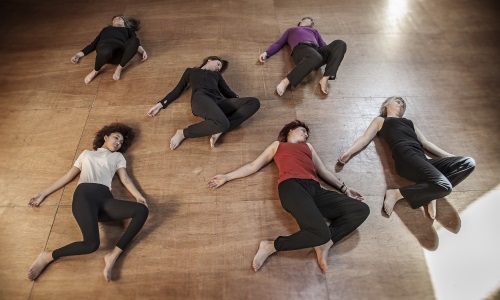by Michael Krugman, GCFP
The Feldenkrais Method® of somatic education is an innovative method of movement education that teaches you to move with greater ease and efficiency so you can enjoy life more. It’s also one of the most effective approaches to stress reduction around. Regular students of the method enjoy better posture, breathing, and coordination as well as greater mental and physical flexibility. They typically report enhanced performance, creativity, and pleasure in activities as diverse as walking, skiing, dancing, running, climbing, golfing, gardening, philosophy, driving, and housekeeping. Feldenkrais® lessons are fascinating and fun!
Now that you know some of the many benefits of the Feldenkrais Method, you’re probably curious enough to want to give it a try. Even so, you may have a number of practical concerns: Is the Feldenkrais Method right for you? How do you find a teacher? Should you prepare in some way? Should you have private Functional Integration® sessions, or go to Awareness Through Movement® group classes? What happens during a Feldenkrais Method class or private lessons? What should you wear? And how many lessons do you need, anyway?
Keep reading, and I’ll attempt to answer all those questions for you. Then you’ll be fully prepared to begin your adventure in the Feldenkrais Method.
- Is the Feldenkrais Method for me?
The Feldenkrais Method is for everyone! Do you enjoy learning new and surprising things about yourself? The Feldenkrais Method could be an indispensable aid in your personal quest.
On a more practical level, the Feldenkrais Method helps people with backaches or muscle and joint pain to discover new options for easier, more pleasurable movement. It helps athletes, musicians, and dancers to “fine tune” themselves for competition or performance. It helps people with stroke, multiple sclerosis, Parkinson’s, or other neurological conditions to find more effective ways to get along in daily life. And it can help anyone, no matter what their age or physical condition, to feel better, relax and enjoy life more.
- How do I find a teacher?
There are teachers of the Feldenkrais Method in most larger cities and many smaller ones in North America. There are over 1200 of us. The Feldenkrais Guild® of North America maintains a directory of Guild Certified Feldenkrais PractitionersCM at their website.
If there is more than one Feldenkrais Method teacher in your area, feel free to call and talk to several teachers before making your choice. Choose a teacher with whom you feel comfortable and can communicate easily. If you like, try an Awareness Through Movement class or individual session with different teachers until you find the one that suits you best.
- Should I prepare in some way?
No preparation is necessary. Just show up on time, with an open mind — and a smile. You will be more comfortable if you avoid eating a full meal for an hour or two before class. Little snacks and liquids are fine.
- Should I have private Functional Integration lessons, or go to Awareness Through Movement group classes?
Awareness Through Movement lessons offer all the benefits of the Feldenkrais Method in a low cost, informal group atmosphere. It’s fun, too! People at all levels of physical fitness take Awareness Through Movement classes. It’s challenging, but not strenuous. If you can do light exercise, you’ll do fine. Consult your doctor if you’re not sure. Individual Functional Integration lessons are for those with special learning needs, who desire accelerated learning, or who simply prefer private study. Students may attend group classes only, private lessons only, or a combination of both (highly recommended!).
If you’re still not sure what to do, talk to your teacher. They will be happy to help you develop a Feldenkrais Method learning program that’s just right for you.
- What happens in a Feldenkrais lesson?
In a group class, your teacher verbally guides you step-by-step through a sequence of gentle, physical movements alternating with periods of quiet rest. Many classes are done while lying on a soft mat on the floor; others are done while sitting, standing, or moving from one to the other. The rest periods between the movements are as important as the movements themselves. They bring you to a state of profound repose while promoting effortlessly effective learning and assimilation. Each class is carefully structured to reveal something new and fascinating about yourself and help you to gain greater self-awareness and more options for action.
Private lessons are similar in purpose to group classes, except that each session is custom tailored to your individual needs and you learn through both touch and verbal means. Your teacher will listen to your interests and concerns, and work with you to define specific goals. Then, through gentle, supportive touch, he or she will guide you through a series of movements that help you get to know yourself better and expand your range of thought, action, and expression.
Most often you will lie on a low, padded table during your Functional Integration lesson. These lessons can also be done in sitting, standing, kneeling, or other positions. Your teacher may also wish to instruct you in relevant “real life” settings such as walking, swimming, playing the piano, gardening, lifting weights, or practicing yoga, for example. The possibilities are endless. Either lesson will probably last 45 minutes to an hour. Some may be longer or shorter. You may also choose to attend workshops consisting of several thematic-related lessons over the course of several hours or days.
- What should I wear?
Any soft, loose-fitting, comfortable clothing that allows you to move freely is fine. You don’t need any special gear for the Feldenkrais Method. Some students prefer to wear leggings, tracksuits, or sweats for comfort and ease of movement.
A few points of etiquette. Avoid wearing perfume, essential oils, or other fragrance on the day of your session, as others may be sensitive. For private lessons, bring socks if you’re not already wearing them.
- What should I expect from my first Feldenkrais lesson?
After your very first lesson, you may find yourself standing a little taller, or feel a little lighter. You may find yourself performing everyday movements with less effort and with greater ease and pleasure. Your breathing may be a little fuller, a little easier. You may feel a sense of heightened curiosity, creativity, and productivity. Truly, the possibilities are endless. They’re as individual as you are.
- How many Feldenkrais lessons do I need?
That depends on how much you want to learn! Your potential for learning and change is limitless. However, it will take several exposures for you to experience the full scope of the Feldenkrais Method. Plan on taking at least six Awareness Through Movement classes or three Functional Integration lessons to get started. With that experience under your belt, you’ll have a better idea of what’s possible and what your individual goals are.
Avid students of the Method may attend for a period of months or years, and they may choose to learn from more than one teacher. Each Guild Certified Feldenkrais Practitioner has something special to offer! With continuing study of the Feldenkrais Method, you will learn to use your own senses to discover the movements that work best for you from moment to moment. That way, you are free to interact spontaneously with your ever-changing environment, wherever you are, whatever you do. As a result, you’ll feel a greater self-confidence and become more closely aligned with your own dreams and desires. That’s a great way to live!
[This article originally appeared on feldenkraisguild.com, and has been lightly edited and updated.]
Featured image by Robert Golden, via the International Feldenkrais Federation.

Michael Krugman was a Guild Certified Feldenkrais Practitioner, founder of the Sounder Sleep System, and author of The Insomnia Solution. An avid Milonguero, he also contributed to the tango community through the Tango Time Machine Facebook Group and Tango Decoder YouTube channel. He passed away in December of 2016, and is greatly missed by all of his communities.

